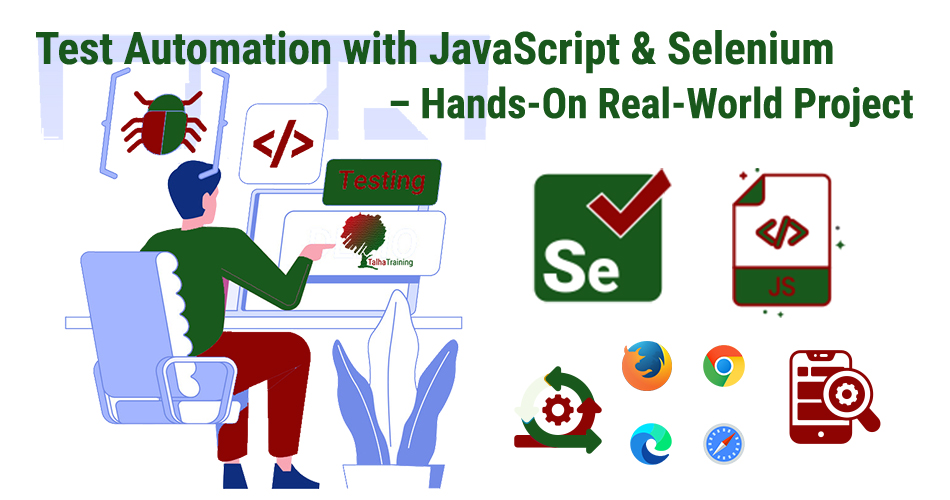Level Up Your QA Career: Learn Python & Selenium with Real Projects!
Level Up Your QA Career: Learn Python & Selenium with Real Projects!
What is Test Automation?
Test automation is the process of using software tools to automatically perform tests on applications—just like a human would do manually, but much faster and more accurately. Instead of manually clicking buttons or typing inputs to verify software behavior, automation uses scripts to execute those actions automatically.
Why Learn Test Automation?
Think of it as a golden ticket to the tech industry!
Test automation professionals are in high demand across the globe. Learning automation is not just about making testing easier—it’s about increasing your efficiency, expanding your career opportunities, and standing out in the competitive job market.
Why Python + Selenium?
Python is one of the most beginner-friendly and powerful programming languages, and Selenium is the go-to framework for browser automation. Together, they create a powerful combo for web test automation.
Learning Python and Selenium empowers you to:
- Automate complex web testing scenarios
- Work across multiple browsers and platforms
- Write clean, scalable test scripts
- Stand out in QA, DevOps, or Full Stack roles
Course Objectives — What You’ll Achieve
- Make Testing Fun & Fast: Learning Python & Selenium makes testing not only efficient but enjoyable! Automate repetitive tasks and focus on what matters.
- Save Time, Work Smarter: Free yourself from manual testing stress by automating common QA tasks, saving valuable time in the development cycle.
- Become a Bug-Busting Hero: Quickly identify and fix bugs before they reach users. Your skills will directly improve product quality.
- Power-Up Your Career: Automation skills open doors to high-paying QA Engineer, SDET, and Automation Architect roles.
- Collaborate Like a Pro: Support your development team by integrating automated testing into CI/CD pipelines, boosting delivery speed.
- Gain Versatile Skills: Whether you’re in freelancing, corporate QA, or startup development—Python + Selenium skills are always in demand.
- Be a Software Guardian: You’ll be the safeguard, catching issues before they become disasters. Your automation scripts will be your shield!
Learning test automation with Python and Selenium is like gaining a trusted, super-efficient teammate that helps you test smarter, work faster, and rise higher in your tech career.
Course Curriculum: Level Up Your QA Career
Learn Python & Selenium with Real Projects
Module 1: Introduction to Test Automation
Objective:
To provide participants with a solid foundation in test automation, emphasizing its role in modern software development, key concepts, tools, and strategies for successful implementation.
Understanding Test Automation Fundamentals
- What is Test Automation and why it matters in the Software Development Life Cycle (SDLC)
- Key benefits (speed, accuracy, repeatability) and challenges (cost, complexity)
Role of Automation Tools in Software Testing
- Overview of industry-standard tools (e.g., Selenium, Appium, JMeter, etc.)
- Introduction to automation frameworks and their role in organizing and optimizing test suites
Introduction to Scripting Languages in Automation
- Comparison of popular scripting languages used in test automation
- Why Python is a top choice: readability, versatility, and wide adoption
Automation Planning & Strategy
- Deciding what to automate and what not to
- Selecting high-value test cases and aligning with business goals
- Building an automation roadmap
Challenges & Best Practices in Automation
- Common pitfalls in writing automation scripts
- Best practices for creating maintainable, scalable, and reusable code
Measuring Success: Metrics & ROI
- Identifying key automation KPIs (e.g., test coverage, pass rate, execution time)
- Calculating and communicating Return on Investment (ROI) from automation efforts
Hands-On Tool Introduction
- Demo of a leading tool (e.g., Selenium)
- Practice running simple automation tests to gain hands-on familiarity
Module 2: Fundamentals of Python for Test Automation
Objective:
To develop core Python programming skills tailored to test automation needs, ensuring participants can confidently write scripts and build test logic.
Introduction to Python Programming
- Python’s popularity in automation, data, and development
- How its clean syntax makes it ideal for beginners and pros alike
Working with Variables, Data Types, and Operators
- Core data types: integers, floats, strings, booleans
- Operators for performing arithmetic, comparisons, and logic checks
Control Structures in Python
- Writing conditional logic using if, elif, and else
- Using for and while loops to automate repetitive actions
Functions and Code Modularity
- Writing reusable functions to simplify complex test logic
- Organizing code into modules for efficiency and clarity
Exception Handling
- Managing runtime errors with try, except, and finally blocks
- Writing robust test scripts that handle unexpected behavior gracefully
Hands-On: Python for Automation
- Writing and executing simple automation tasks using Python
- Practical exercises simulating real-world QA scenarios
- Recap and quick quizzes to reinforce understanding
Module 3: Introduction to Selenium WebDriver with Python
Objective: Introduce participants to Selenium WebDriver and demonstrate how it integrates with Python to automate real-world web applications.
Understanding Selenium and Its Role in Automation
- What is Selenium and why it’s a preferred tool for web automation
- Key capabilities and benefits of using Selenium WebDriver
Setting Up Selenium with Python
- Installing required tools and libraries (e.g., selenium, WebDriver)
- Configuring your development environment for Python-based Selenium automation
Interacting with Web Elements
- Identifying and interacting with elements like text fields, buttons, and links
- Writing simple scripts to automate common browser tasks
Navigation and Browser Control
- Automating page navigation (back, forward, refresh)
- Controlling the browser window and handling alerts or popups
Managing Waits and Synchronization
- Challenges with loading times and dynamic content
- Using implicit and explicit waits to create stable test scripts
Hands-On Practice
- Practice exercises with real websites
- Applying your learning to write beginner-level automation scripts using Selenium and Python
- Guidance on expanding toward more complex use cases
Module 4: Web Element Locators and Interactions
Objective: Teach participants how to accurately locate and interact with web elements using a variety of techniques to build reliable automation scripts.
Introduction to Web Element Locators
- Types of locators: ID, Name, Class Name, Tag Name, Link Text, XPath, and CSS Selector
- When and how to use each locator effectively
Locating Web Elements in Practice
- Hands-on exercises using different locators
- Writing Python-Selenium scripts to interact with common elements like forms, buttons, dropdowns, etc.
Mastering XPath and CSS Selectors
- Deep dive into XPath and CSS for locating complex and nested elements
- Writing dynamic XPath expressions and CSS selectors for stable automation
Strategies for Reliable Element Identification
- Techniques to write maintainable locators that resist UI changes
- Handling dynamic IDs and changing DOM structures
Working with Different Web Elements
- Interacting with input fields, checkboxes, radio buttons, dropdowns, etc.
- Simulating user behavior like selecting options, submitting forms, and validating responses
Real-World Scenarios & Practice
- Scenario-based challenges to reinforce learning
- Encouragement to explore real applications and test different types of web interactions
Module 5: Handling Dynamic Elements and Waits in Python
Objective: Equip participants with the skills to manage dynamic content, handle synchronization issues, and ensure robust, reliable test automation.
Understanding Dynamic Elements
- What are dynamic elements and why they are challenging in automation
- Recognizing dynamically loaded content (e.g., AJAX calls, loaders)
Implementing Implicit and Explicit Waits
- How implicit waits work behind the scenes
- Mastering explicit waits using WebDriverWait and expected conditions
Dealing with AJAX and Page Load Delays
- Techniques to handle elements that load asynchronously
- Writing scripts that wait for conditions before proceeding
Synchronization & Timing Challenges
- Identifying and fixing flaky tests caused by poor synchronization
- Using wait strategies to stabilize test scripts
Best Practices for Dynamic Content
- Building test scripts that adapt to changing UI
- Writing reusable, time-efficient, and stable wait methods
Hands-On with Dynamic Scenarios
- Practice tasks simulating dynamic interactions (e.g., loading spinners, delayed content)
- Writing complete scripts to demonstrate reliable automation in real-world situations
- Recap and encouragement to continue refining and practicing your skills
Module 6: Advanced Interactions & Actions in Python
Objective: Equip participants to automate complex user interactions using Selenium WebDriver with Python.
- Advanced User Interactions: Learn to simulate drag & drop, hover, and right-click scenarios.
- Using the Actions Class: Perform advanced actions using Selenium’s Actions class with Python.
- Mouse & Keyboard Control: Automate clicks, double-clicks, drags, and keystrokes programmatically.
- Managing Windows & Frames: Switch between multiple windows and interact with iframes.
- Complex Scenarios: Automate file uploads, alerts, confirmations, and user flows.
- Hands-on Practice: Apply learned techniques to real-life advanced interaction cases.
Outcome: Confidently automate sophisticated UI behaviors across various web applications.
Module 7: Page Object Model (POM) with Python
Objective: Introduce participants to the POM design pattern to build scalable and maintainable test automation frameworks.
- What is POM? Learn how to organize automation code using reusable page classes.
- Designing Page Objects: Create structured Python classes to represent pages & actions.
- Code Cleanliness: Group and organize UI elements and interactions for better maintainability.
- Refactoring with POM: Convert existing scripts to a structured, modular approach.
- Handling Navigation: Implement seamless workflows between multiple pages.
- Best Practices: Handle dynamic content and structure POM repositories for long-term use.
- Hands-on Practice: Build real project pages using POM in Python + Selenium.
Outcome: Develop clean, reusable automation scripts following industry-standard architecture.
Module 8: Test Frameworks & Reporting in Python
Objective: Enable participants to efficiently structure, execute, and report on automated tests using Python frameworks.
- Intro to Frameworks: Understand the role of testing frameworks in automation.
- Unittest Framework: Build and manage test cases using Python’s built-in framework.
- Getting Started with Pytest: Use powerful features like fixtures, assertions, and parametrized tests.
- Test Execution & Organization: Group, prioritize, and manage test suites efficiently.
- Test Reporting: Generate and customize reports with built-in and third-party libraries.
- Visual Reports: Use graphs/charts to display test performance and results.
- CI/CD Integration: Integrate test scripts with Jenkins/Travis CI for continuous automation.
- Hands-on Practice: Run tests, generate reports, simulate real-time automation with CI tools.
Outcome: Master the full testing lifecycle from execution to insightful reporting and automation integration.
Module 9: Debugging and Troubleshooting in Python Automation
Objective: Empower participants with practical debugging skills and troubleshooting techniques necessary for diagnosing and resolving common issues in Python-based test automation.
Understanding the Debugging Process
- Recognize frequent automation challenges and adopt a systematic approach to debugging.
- Understand debugging workflows and logical strategies to trace issues.
Debugging Techniques in Selenium
- Troubleshoot common Selenium errors like element not found, timeouts, and sync issues.
- Implement logging and monitoring to capture meaningful data during test runs.
Error Handling & Exception Management
- Grasp exception types and efficient use of try-except blocks.
- Develop scripts that gracefully handle runtime errors.
Troubleshooting Framework Failures
- Analyze unittest/pytest failures and trace root causes.
- Learn framework-specific techniques to isolate issues.
Logging & Reporting for Debugging
- Incorporate logging libraries (e.g., logging) for traceability.
- Generate detailed logs and error reports to support post-execution reviews.
Hands-on Practice
- Work through real-world debugging scenarios.
- Gain confidence by resolving automation script errors during exercises.
Module 10: Advanced Topics in Selenium with Python
Objective: Explore advanced Selenium topics and tackle complex web interaction scenarios using Python.
Handle complex use cases like:
- File uploads
- JavaScript pop-ups
- Iframes and nested frames
Simulate intricate user flows and UI behaviors
Customize interaction strategies for dynamic web applications
Module 11: Real-World Projects and Case Studies
Objective: Apply your learning through real-world test automation projects and case studies.
Outcomes:
- Work on real-time automation projects simulating enterprise-grade applications.
- Tackle common challenges faced in live environments.
- Gain practical exposure by solving real automation problems using Python and Selenium.
Become Job-Market Ready with Real Automation Skills!
This course is your fast track to mastering Python & Selenium for real-world test automation. Whether you’re a QA professional, developer, DevOps engineer, freelancer, or test lead—this hands-on training will empower you to:
- Build scalable automation frameworks
- Write professional test scripts
- Solve real-world testing challenges
- Launch a future-proof QA career
🎯 Don’t just learn—implement. Don’t just automate—lead!
Why Join This Course?
- 100% Hands-On Practice with Real Web Apps
- Real Project-Based Learning
- Learn Page Object Model (POM), Advanced Selenium & Automation Patterns
- Globally Accepted Techniques and Best Practices
- Certificate of Completion
- Hybrid Mode: Online Live + Offline (Classroom)
Course Tools & Technologies
- Python, Selenium WebDriver
- PyTest, Unittest
- VS Code, Git
- HTML Reports, Allure
- Real-world web apps for testing
- CI Tools (Jenkins, GitHub Actions)
Enrollment Information
Limited Seats Available – Enroll Now!
Secure your seat by paying the course fee via bank transfer.
Bank Details:
- Account Name: TalhaTraining
- Account No.: 2141116000973
- Bank Name: Prime Bank Limited
- SWIFT Code: PRBLBDDH
- Routing Number: 170263614
📩 After payment, email your:
- Name
- Phone Number
- Payment Slip
- To: training@talhatraining.com or talhatraining@gmail.com
Contact & Support
Need help deciding if this course is right for you?
Our support team is ready to assist you at every step.
📱 Call / WhatsApp: +8801712742217
📧 Email: training@talhatraining.com | talhatraining@gmail.com
🌐 Website: talhatraining.com | hostbari.com
Your Automation Journey Starts Here
Join a growing community of future-proof QA professionals, automation engineers, and tech-savvy testers.
Learn. Automate. Lead.
Be the QA expert every team needs!

Discover Courses That Fit You
-
0 Lessons
-
0 Lessons
-
0 Lessons
-
0 Lessons



